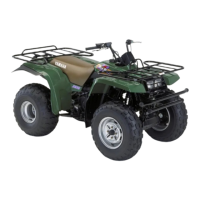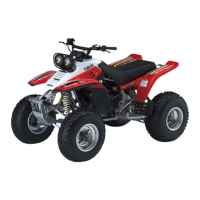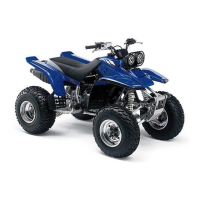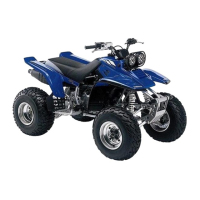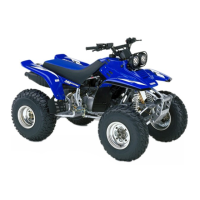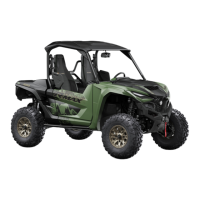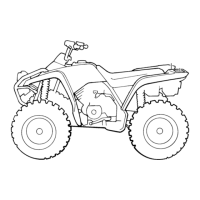Do you have a question about the Yamaha WaveRunner SuperJet 2020 and is the answer not in the manual?
Information for proper operation, maintenance, and care of the watercraft.
Details on PRI-ID, HIN, and engine serial numbers for owner reference.
Guide to understanding various labels on the watercraft before use.
Details on other labels, including capacity and competition use.
Requirements for operators, including age, qualifications, and safe cruising guidelines.
Essential equipment and personal protective measures for safe watercraft operation.
Information on fuel handling, fumes, and understanding jet thrust operation.
Navigational rules and resources for obtaining additional boating safety information.
Guidelines for responsible operation, environmental care, and community courtesy.
Definitions of key terms used to describe watercraft operation and parts.
Diagrams and labels identifying the principal parts of the watercraft.
Operation of the engine stop, shut-off, and start switches for safe control.
How to operate the throttle lever and steering system for control and maneuverability.
Instructions for operating the fuel cock knob and choke knob for starting and running.
Information on the cooling water pilot outlet and its function for system monitoring.
Function of the water separator and the engine overheat warning system.
Step-by-step guide for removing and installing the watercraft hood.
Details on bow/stern rope holes for towing/mooring and the storage pouch.
Location and operation of the fire extinguisher container.
Recommended fuel types, octane ratings, and 2-stroke engine oil specifications.
Proper ratios for mixing fuel and oil, and procedure for filling the fuel tank.
Procedures for draining bilge water from the engine compartment, on water or land.
Guidelines for safely transporting the watercraft on a trailer.
Steps for breaking in the engine to ensure longevity and performance.
A comprehensive checklist of pre-launch and post-launch checks for safe operation.
Detailed checks for the engine compartment and fuel system before launching.
Checks for water separator, engine unit, battery, and steering system.
Checking the steering pole and throttle lever for smooth operation and proper free play.
Verifying the engine shut-off cord, switches, and storage pouch.
Checks for fire extinguisher, hull, jet intake, and hood security.
Checks to perform after launching and starting the engine on the water.
Ensuring water discharge from the cooling water pilot outlet.
Familiarizing with controls and basic techniques for safe operation.
Guidance on kneeling/standing positions and launching the watercraft.
Step-by-step instructions for starting the engine in the water.
Procedures for stopping the engine and leaving the watercraft safely.
Techniques for operating at speed and making turns safely.
Methods for stopping the watercraft and starting from a standstill.
Instructions for boarding and starting the engine in shallow water conditions.
Guidance on boarding and starting the engine in deep water.
Steps to properly upright a capsized watercraft and avoid engine damage.
Procedures for beaching the watercraft and operating in weedy areas.
Steps for discharging residual water from cooling passages after use.
Essential steps after using the watercraft, including fuel shut-off and flushing.
Instructions for cleaning the watercraft and maintaining the battery.
Detailed checks for battery condition, electrolyte level, bands, and storage.
Procedures for long-term storage and cleaning, including fuel stabilization.
Guidance on lubricating moving parts with water-resistant grease.
Steps for rustproofing internal engine components using fogging oil.
Overview of periodic maintenance and the included tool kit.
How to adjust the steering friction to suit operator preference.
Procedure for adjusting the jet thrust nozzle angle to two settings.
Chart outlining recommended periodic checks and maintenance tasks.
Instructions for checking spark plug condition and proper installation.
Maintenance tasks for lubrication, fuel filter, choke cable, and carburetor.
Procedure for adjusting the engine idling speed using a diagnostic tachometer.
Detailed technical specifications including dimensions, performance, engine, and fuel.
Chart to identify possible causes and remedies for common watercraft issues.
Steps for cleaning the jet intake and impeller safely.
Procedures for jump-starting the battery and replacing a blown fuse.
Instructions for safely towing the watercraft if it becomes inoperative.
Steps for handling a submerged watercraft, including draining and servicing.
Details on the watercraft's 'as is' sale and purchaser's responsibility for costs.
Information for proper operation, maintenance, and care of the watercraft.
Details on PRI-ID, HIN, and engine serial numbers for owner reference.
Guide to understanding various labels on the watercraft before use.
Details on other labels, including capacity and competition use.
Requirements for operators, including age, qualifications, and safe cruising guidelines.
Essential equipment and personal protective measures for safe watercraft operation.
Information on fuel handling, fumes, and understanding jet thrust operation.
Navigational rules and resources for obtaining additional boating safety information.
Guidelines for responsible operation, environmental care, and community courtesy.
Definitions of key terms used to describe watercraft operation and parts.
Diagrams and labels identifying the principal parts of the watercraft.
Operation of the engine stop, shut-off, and start switches for safe control.
How to operate the throttle lever and steering system for control and maneuverability.
Instructions for operating the fuel cock knob and choke knob for starting and running.
Information on the cooling water pilot outlet and its function for system monitoring.
Function of the water separator and the engine overheat warning system.
Step-by-step guide for removing and installing the watercraft hood.
Details on bow/stern rope holes for towing/mooring and the storage pouch.
Location and operation of the fire extinguisher container.
Recommended fuel types, octane ratings, and 2-stroke engine oil specifications.
Proper ratios for mixing fuel and oil, and procedure for filling the fuel tank.
Procedures for draining bilge water from the engine compartment, on water or land.
Guidelines for safely transporting the watercraft on a trailer.
Steps for breaking in the engine to ensure longevity and performance.
A comprehensive checklist of pre-launch and post-launch checks for safe operation.
Detailed checks for the engine compartment and fuel system before launching.
Checks for water separator, engine unit, battery, and steering system.
Checking the steering pole and throttle lever for smooth operation and proper free play.
Verifying the engine shut-off cord, switches, and storage pouch.
Checks for fire extinguisher, hull, jet intake, and hood security.
Checks to perform after launching and starting the engine on the water.
Ensuring water discharge from the cooling water pilot outlet.
Familiarizing with controls and basic techniques for safe operation.
Guidance on kneeling/standing positions and launching the watercraft.
Step-by-step instructions for starting the engine in the water.
Procedures for stopping the engine and leaving the watercraft safely.
Techniques for operating at speed and making turns safely.
Methods for stopping the watercraft and starting from a standstill.
Instructions for boarding and starting the engine in shallow water conditions.
Guidance on boarding and starting the engine in deep water.
Steps to properly upright a capsized watercraft and avoid engine damage.
Procedures for beaching the watercraft and operating in weedy areas.
Steps for discharging residual water from cooling passages after use.
Essential steps after using the watercraft, including fuel shut-off and flushing.
Instructions for cleaning the watercraft and maintaining the battery.
Detailed checks for battery condition, electrolyte level, bands, and storage.
Procedures for long-term storage and cleaning, including fuel stabilization.
Guidance on lubricating moving parts with water-resistant grease.
Steps for rustproofing internal engine components using fogging oil.
Overview of periodic maintenance and the included tool kit.
How to adjust the steering friction to suit operator preference.
Procedure for adjusting the jet thrust nozzle angle to two settings.
Chart outlining recommended periodic checks and maintenance tasks.
Instructions for checking spark plug condition and proper installation.
Maintenance tasks for lubrication, fuel filter, choke cable, and carburetor.
Procedure for adjusting the engine idling speed using a diagnostic tachometer.
Detailed technical specifications including dimensions, performance, engine, and fuel.
Chart to identify possible causes and remedies for common watercraft issues.
Steps for cleaning the jet intake and impeller safely.
Procedures for jump-starting the battery and replacing a blown fuse.
Instructions for safely towing the watercraft if it becomes inoperative.
Steps for handling a submerged watercraft, including draining and servicing.
Details on the watercraft's 'as is' sale and purchaser's responsibility for costs.
| Brand | Yamaha |
|---|---|
| Model | WaveRunner SuperJet 2020 |
| Category | Offroad Vehicle |
| Language | English |


